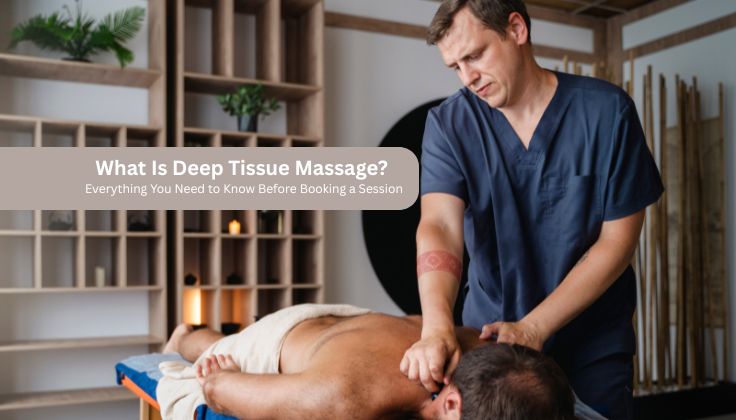


One of the many ways that massage therapy brings relaxation to the human body is by healing and nourishing it. Highest recommendations are generally given for deep tissue massages in cases of people having chronic pain, stiffness, or muscle tension.
Deep tissue massage therapy is among those massage prescriptions that can complement the recovery process through the traditional route of wellness approaches like Panchakarma Treatment in Dubai, or even the modern ones. But what exactly is deep tissue massage? Will you be suitable to avail one? And what should you know before booking your very first deep tissue massage session?
Deep tissue massage works therapeutically on deeper layers of muscles and connective tissues. Whereas Swedish massage is gentle strokes mainly for relaxation, in massage techniques, deep tissue means slow, deliberate pressure applied to reach deep muscle fibers and fascia, connective tissue surrounding the muscles.
Therapists use their fingers, forearms, elbows, and knuckles to exert firm pressure on muscle-clogged areas to release knots in the muscles, promote bonding, increase mobility, and remove chronic tension. The treatment is used mainly in therapy, acute rehabilitation, and musculoskeletal medicine.
The deep tissue massage suits people who suffer from chronic muscular pains, tightness, or limited motion. The common clientele includes people recovering from injuries or coping with postural problems, while deep tissue massage serves as one stress-buster. It is a therapy that keeps athletes and active people on their feet by supporting performance and recovery. But it is not for everyone, and those with certain health conditions-those at risk for blood clotting, high osteoporosis, or pregnancy-should consult a health professional before scheduling a session.
While many associate massage with relaxation, the benefits of deep tissue massage go much further. One of the primary advantages is the relief it offers from chronic tension. By targeting deep-seated muscle tightness, it helps improve flexibility and ease discomfort. It also promotes better blood circulation, which can accelerate healing and reduce inflammation.
Another major benefit is stress relief. When muscles are tense, the body carries that tension mentally as well. A good deep tissue massage can leave you feeling physically and emotionally lighter. Over time, it may even help correct postural imbalances and reduce the physical effects of stress and anxiety.
If you’ve never had a deep tissue massage before, it helps to know what the experience entails. Your session will usually begin with a brief consultation. The therapist will ask about your health history, current symptoms, and the areas you’d like them to focus on. This step is important, as it allows the massage to be tailored to your needs.
The therapist will typically start with lighter pressure to warm up your muscles before gradually increasing intensity. Expect a mix of slow, firm strokes and deep pressure applied using different parts of the therapist’s body. The goal is to reach problem areas without causing sharp pain. Some discomfort is normal, especially when working on tense muscles, but you should always speak up if the pressure becomes too intense.
Sessions often last between 60 and 90 minutes, depending on the areas treated and your goals.
After a deep tissue massage, it’s common to feel a little sore, similar to how you might feel after an intense workout. This is a normal reaction to the deep pressure applied during the session and usually subsides within a day or two.
To support your body’s recovery, consider the following post-massage tips:
These small steps can enhance the benefits of your massage and support your body’s natural healing process.
Going into your session well-prepared can make the experience more comfortable and effective. Ideally, arrive a few minutes early so you’re not rushed. Wear comfortable clothing, stay hydrated, and have a light meal at least an hour before the massage.
Avoid:
Being honest about how you’re feeling helps the therapist make real-time adjustments to ensure the massage is beneficial and not overly intense.
A few myths tend to follow deep tissue massage. One is the belief that the massage must be painful to be effective. While some level of discomfort can occur, especially when targeting problem areas, pain is not a necessary component. A good therapist will work within your comfort zone to achieve the desired results.
Another common misunderstanding is that deep tissue massage is only for athletes or people with injuries. In reality, anyone dealing with muscular tension or stress can benefit. It's also worth noting that one session may not solve everything. Chronic issues often require a series of treatments combined with self-care and physical awareness.
Not all massage therapists specialize in deep tissue work, so it’s important to choose someone with the right qualifications and experience. Look for a licensed therapist with training in deep tissue techniques and a solid understanding of anatomy and body mechanics. Reading reviews or getting personal recommendations can also guide you toward a skilled professional.
A good therapist will listen to your concerns, explain their approach, and ensure that the pressure applied suits your needs. Don’t hesitate to ask questions; it’s your body, and you deserve to feel safe and supported.
Deep tissue massage can offer lasting relief for people dealing with physical discomfort, stress, or restricted mobility. It’s a powerful therapy that goes beyond surface-level relaxation, addressing the deeper issues your body may be holding onto.
By understanding what to expect, preparing thoughtfully, and communicating with your therapist, you can make the most of your session. Whether you're an athlete, a desk worker with tension, or someone simply looking to feel better in their own body, deep tissue massage could be exactly what you need. If you're exploring holistic healing options or complementing your Ayurvedic treatment in Dubai, deep tissue massage may be a valuable addition to your wellness routine.